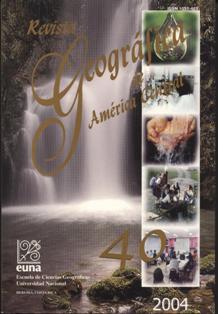ESTUDIO PILOTO SOBRE LA EVALUACIÓN CUALITATIVA DE LOS PROBLEMAS Y PROPUESTAS DE SOLUCIÓN PARA EL USO DEL RECURSO HÍDRICO EN LA SUBCUENCA DEL RÍO VIRILLA
Palabras clave:
Análisis de múltiples criterios, evaluación multicriterio, administración hídrica, modelo de telaraña, Multi-critena analysis, participant observation, multi-criteria evaluation, hydric administration, model of spider’s web.Resumen
La experiencia en la gestión de cuencas, en particular en su aspecto hídrico-social, indica que el problema surge por causalidad recíproca de distintos factores biológicos y socioeconómicos, ligados a una gestión del desarrollo, que por lo común, no atiende los riesgos que crea. La gestión efectiva de los recursos hídricos y bióticos involucrados suele ignorar el conflicto que. en términos sociales, traen consigo los usos no sustentables. Por tanto, una gestión alternativa exige un enfoque integral, que busque relacionar valores sociales (no únicamente económicos) con criterios ecológicos y con otros parámetros diversos.La integral idad de la gestión de cuencas depende de que las decisiones estén sujetas tanto a sistemas de planificación territorial, con la perspectiva abierta sobre los ecosistemas boscosos (protección de cuencas, control de erosión, ciclo del carbono, recreación, etc.) como a sistemas interdependientes de preferencias o toma de decisiones sociales.
Lo anterior no se puede evaluar eficientemente con las técnicas convencionales de valoración, ni con las herramientas de la economía ambiental y de recursos naturales para países en desarrollo. Si bien esas técnicas son útiles en la administración de algunos recursos estratégicos. no son suficientes cuando se trata de valorar ambientes donde se debe enfrentar limitaciones en términos de indeterminación, incertidumbre, indivisibilidad, racionalidades sujetas a decisiones colectivas e individuales o a cuestiones de distribución socioecológica.
El diseño metodológico aquí presentado ha permitido identificar los diferentes actores involucrados, describiendo, al mismo tiempo, los problemas de gestión que enfrentan y ha pennitido delimitar los conflictos sociales y mostrar diferentes posibilidades para su solución por medio de compromisos, cooperación y diálogo entre las panes, dando oportunidad que emergieran soluciones para el manejo integral de la subcuenca del no Viruta.
Abstract:
The experience in the administration of basins, in particular in their social-hydric aspect, it indicates that thc problem anses for reciprocal causation of different biological and socioeconomic factors, bound toan administration of dic development thai in general doesn’t assist dic risks thai shelhe believes. The effectivc administration of the hydrics resources and involved biotic usually ignore dic conflict that, in social terms. she/he brings 1 gel the non sustainablc uses. Therefore. an alternative administration demands an integral focus thai looks for to relate social values (nol only economic) to ecological approaches and other diverse parameters.
The composedly of dic basin administration depends thai the decisions are subject to systems of territorial planning. with dic open perspective on the wooded ecosystems (basin protection, erosion control. cycle of the carbon. recreation, etc.) as much as Lo intcrdcpendeni systems of preferences or taking of social decisions.
The above-mentioned you can nol evaluate efficiendy with the conventional techniques of valuacion, neithcr with the tools of the environmental economy and of natural resources for countries in development. Although those techniques are useful in ihe administration of sorne strategic resources. they are fol enough when it is to value atmospheres where it should be faced limitations in indetermination terms. uncertainty, indivisibility, rationalities subject to collecuve and individual decisions. or to questions of partner-ecological distribution.
The mcthodological design here prescnted it has allowcd lo ideniify. the different involved actors, describing, al the same time, dic administration problems that face and it has allowed to define the social contlicts and to show different possibilities for dic their solution through comrnitments, cooperation and dialogue arnong dic paris. giving opportunity thai solutions emerged for the integral handling of the Vinila river basin.
Descargas
Cómo citar
Número
Sección
Licencia
Política propuesta para Revistas que ofrecen Acceso Abierto
Los autores que publican en esta revista están de acuerdo con los siguientes términos:
a. Los autores conservan los derechos de autor y garantizan a la revista el derecho de ser la primera publicación del trabajo, bajo la Licencia https://creativecommons.org/licenses/by-nc-sa/4.0/deed.es, que permite a otros compartir con un reconocimiento de la autoría del trabajo y la publicación inicial en esta revista.
b. Los autores pueden establecer por separado acuerdos adicionales para la distribución no exclusiva de la versión de la obra publicada en la revista (por ejemplo, situarlo en un repositorio institucional o publicarlo en un libro), con un reconocimiento de su publicación inicial en esta revista. Esos acuerdos adicionales deben respetar los términos de la licencia: es decir: no involucrar fines de lucro y compartir con la misma licencia.
c. Se anima a los autores a archivar el post-print o versión de editor/PDF en repositorios de acceso abierto.







 REVGEO se encuentra bajo la licencia https://creativecommons.org/licenses/by-nc-sa/4.0/deed.es
REVGEO se encuentra bajo la licencia https://creativecommons.org/licenses/by-nc-sa/4.0/deed.es
.svg_4.png)

_(1).png)
_(1)_(1)_(1)_1.png)
(2)(1)(1)(1).png)
